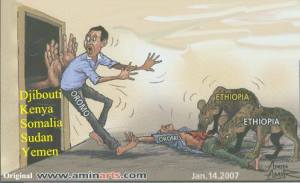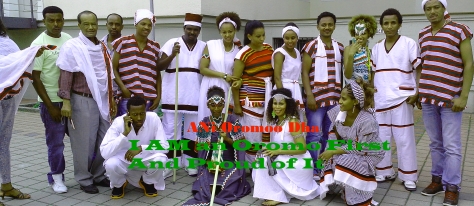The Oromo people who constitute more than forty percent of the population in Ethiopia have become the target of attack by the minority Tigrayan Peoples Liberation Front (TPLF) dominating Ethiopian regime. Because of these continues and deliberate attack, we the Oromo people are continuously briefing and also trying to show the world in all possible ways all sort of the human rights violation against us. So, through the concerned body Like The Oromo Studies Association (OSA), the Oromo Community Organization (OCO) of Washington D.C. Metropolitan area, the Oromo Youth Self-help Association (OYSA), the Human Rights League of the Horn of Africa (HRLHA), Oromo Menschenrechts und Hilfsorganisation (OMRHO e.V) and the Oromia Support Group (OSG), appeal letters request are usually done to the US and all the EU Government to have an influence on the dictatorial Ethiopian government in order to end its harassment , arbitrary arrests, extrajudicial killing, kidnappings, tortures, sentencing for long prison terms and killings of innocent Oromos and other Ethiopian citizens for the only crime of being an advocate to the general good.These organizations are a diverse group of scholarly, community, and human rights organization deeply concerned about the wide spread human rights violation that continue unabated in Ethiopia focusing particularly on Oromia, the Oromo regional state in Ethiopia and Ethiopia in general. And these scholarly, community and human rights organizations are always briefing and becoming a voice for these voiceless oromo people .
The well known Oromo opposition politician prisoners, Bekele Gerba and Olbana Lelisa were arrested in August 2011 after speaking with Amnesty International officials. They were sentenced with seven other Oromo nationals ,Welbeka Lemi, Adem Busa, Hawa Wako, Mohamed Melu, Dereje Ketema, Addisu Mikre and Gelgelo Gufa in November 2012 and were convicted and later sentenced to long prison terms for working against this TPLF ethnocratic government under the charge of “working underground to secede Oromia from the federal government” and other concocted charges after being kept in jail for more than a year. On September 30, 2012, about 200 Oromo youth were rounded up and arrested when they were peacefully celebrating the annual Irreechaa festival (thanksgiving) at Lake Arsadi, Bushoftu, Oromia. Four months after their arrest The Human Rights League of the Horn of Africa (HRLHA) has published the names of 50 of the youth arrested at this festival. Moreover, arbitrary arrest of hundreds of Ethiopian Muslims on almost weekly basis has continued for about a year and there seems no end in sight to it. Just recently, on January 2, 2013, HRLHA has also published the names of 99 students of Addis Ababa University, mainly Oromos, who have been arrested and severely beaten.
Over the past 21 years, the TPLF-led and dominated Ethiopian government, has imprisoned tens of thousands of political opposition and citizens, mainly Oromos. As the result of the government’s repressive policies, thousands of innocent citizens have been languishing in prisons and secret camps and many have been severely tortured, deformed and/or killed. Others have been abducted and made to disappear. Hundreds have been murdered in broad day-light. Well respected human rights organizations such as Amnesty International, Human Rights Watch, and the US State Department’s own annual reports have documented rampant arrests, unlawful killings, abductions, tortures and other human rights abuses by the Ethiopian government. Despite these glaring facts and experiences of the oromo peoples and other citizen human right violations, Ethiopia’s allies and Western donors are reluctant to restrain the government and halt its flagrant human rights abuses. Some donors even go on record to support the government’s wrong claim that Ethiopia is “on the road to democracy.” It is troubling that despite these well documented human rights abuses, the Ethiopian government continues receiving billions of dollars of aid money every year. Using over one third of its budget from foreign aid, Ethiopia has built one of the biggest and best-equipped armies in Africa, while millions of its citizens seek food aid. In fact, the aid money is used to impose the Tigrayan dictatorship and ethnocratic regime on Oromos and other peoples in a multinational society.
While thousands of Oromos and others are languishing in prisons under bogus terrorism charges, at a recent session of the parliament and on Aljezeara interviewthe current Prime Minister of Ethiopia, Mr. Hailemariam Dessalegn, made an utterly false claim in public that there are no political prisoners in Ethiopia. Such blatant misinformation has been the norm of the entire leadership of the regime that is intended to deceive international donors and allies. In his inauguration speech, the new prime minister also promised to continue implementing the policies of the late dictatorial Prime Minister Meles Zenawi; this, is a clear indication that the new prime minister is under the control of the Tigrayan elite and that he cannot make any reform and democratic changes in Ethiopia. Observing the painful agony and sufferings of the ordinary people, the political prisoners in particular, and the lack of any progress towards democratic change in Ethiopia, we all the oromo people and Ethiopian citizens having the same problem of receiving this continues repression earnestly shout to the US and European government to use their influence with the Ethiopian government and facilitate the release of all political prisoners and to take practical action to promote real democratic changes in the country.
So in order to unconditionally release all the oromos and other Ethiopian political prisoners, stop the regime’s extrajudicial killings and arbitrary arrests of innocent oromo people and prolonged detention without trial, respect human rights of the Oromo and other nations and nationalities of Ethiopia and allow freedom of expression and assembly, repeal violation of the fundamental freedom of citizens: particularly the so called Anti-terrorism Law, Press Law and others, stop harassing journalists and jamming VOA and other free radio stations broadcasting to Ethiopia, stop the unlawful evictions of Oromos and illegal selling of Oromo land immediately, respect freedom of religion and stop interfering in religious affairs, Ethiopian donors and allies have to put enough pressure on the TPLF government to listen to the voice of its citizens. Moreover, We the oromo people and other peace loving nation and nationalities in Ethiopia should stand firm together to advocate to the voiceless and keep the political struggle to bring peace, stability, freedom, justice and democracy to the entire nation and nationalities in Ethiopia.
Mezbebu Demeke Boru


